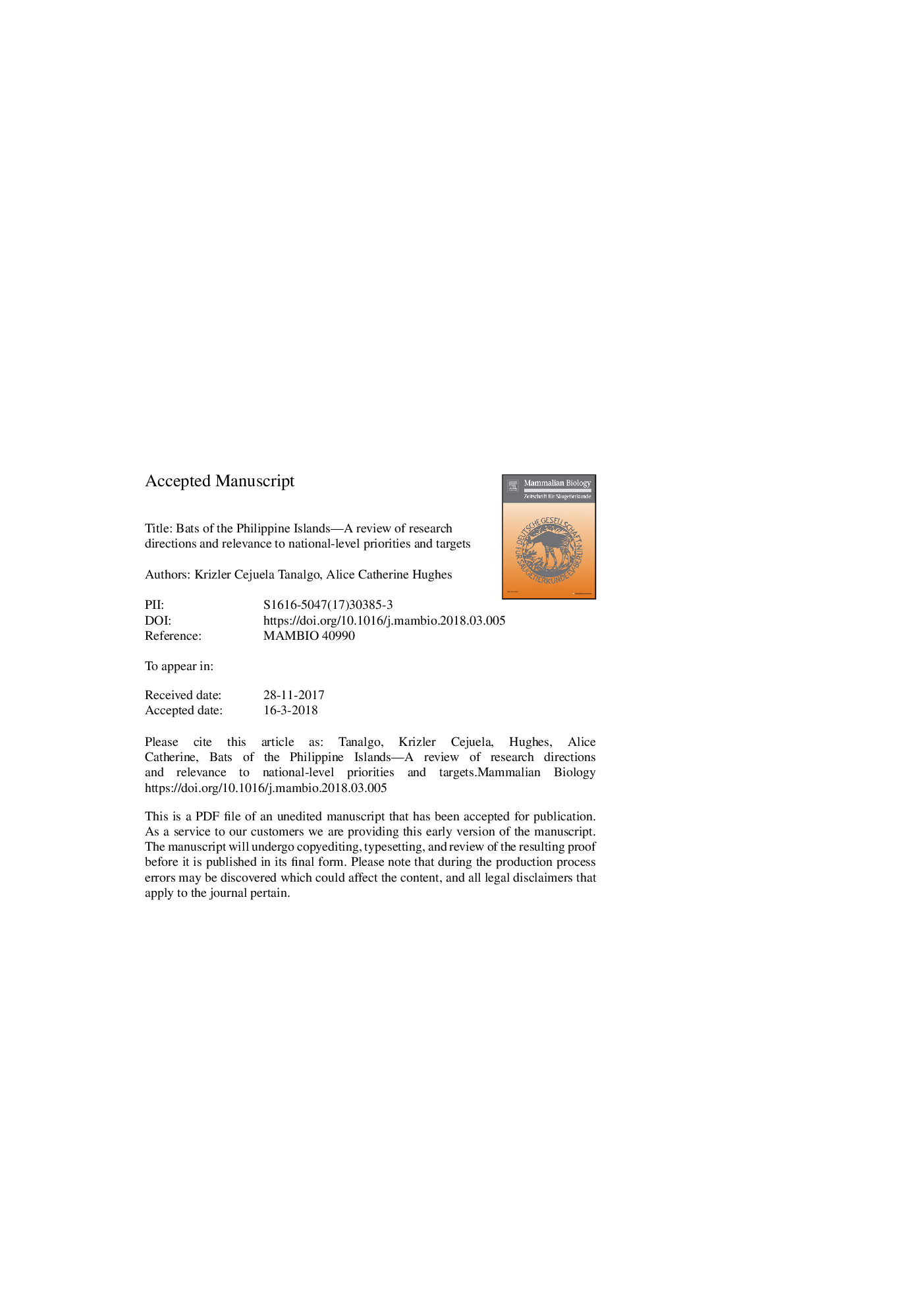| کد مقاله | کد نشریه | سال انتشار | مقاله انگلیسی | نسخه تمام متن |
|---|---|---|---|---|
| 8475563 | 1550456 | 2018 | 33 صفحه PDF | دانلود رایگان |
عنوان انگلیسی مقاله ISI
Bats of the Philippine Islands-A review of research directions and relevance to national-level priorities and targets
ترجمه فارسی عنوان
خفاش ها جزایر فیلیپین - مرور مسیرهای تحقیق و ارتباط با اولویت ها و اهداف ملی
دانلود مقاله + سفارش ترجمه
دانلود مقاله ISI انگلیسی
رایگان برای ایرانیان
کلمات کلیدی
حفاظت، جزایر، لیست قرمز ملی اولویت های، تلاش های پژوهشی،
ترجمه چکیده
اولویت های حفاظت شده مبتنی بر علم و سیاست ها برای تأمین موثریت تنوع زیستی در آینده بسیار مهم است. برای بسیاری از گونه ها و سیستم های تهدید شده، اطلاعات کافی برای تولید اولویت ها یا سازوکارهایی که برای حفظ و حفظ مؤلفه های آینده در آینده ضروری است، وجود دارد و این به ویژه در کشورهایی مثل مکزیک مانند فیلیپین که با سرعت رشد سریع تهدید می شود و با چند راهبرد کلی تنوع زیستی خود را حفظ کنید. در اینجا، با استفاده از یک رویکرد کتابشناختی برای نشان دادن نقاط قوت و اهداف تحقیق، اطلاعات علمی مربوط به خفاشهای فیلیپین در سالهای 2000 تا 2017 را خلاصه کردیم. روابط بین موضوعات موضوعی و تلاش برای هر گونه گونه، گروه رژیم و وضعیت حفاظت را بررسی می کنیم. ما دریافتیم که به طور متوسط سالانه 7.9 مطالعه انجام شده است که اکثریت آن ها بر روی تنوع و نظرسنجی های اجتماعی تمرکز دارند. با این وجود، تلاش های پژوهشی حتی بین گروه های طبقه بندی، مناطق موضوعی یا گونه های مختلف وجود ندارد، و تلاش های نامناسب برای تمرکز بر "طبقه بندی و سیستماتیک" و "محیط زیست" است. تخصیص منابع بین گونه های تهدید شده و کمتر تهدید می کند تفاوت قابل توجهی را نشان نمی دهد، گرچه ممکن است به این دلیل باشد که گونه های عمومی در بسیاری از مطالعات یافت می شوند، در حالی که گونه های نادر تر مطالعات تک گونه ای به آنها اختصاص داده شده است. تلاش های مشترک در زمینه ابتکارات حفاظت از حیوانات در فیلیپین بر حفاظت از بسیاری از گونه های اندمیک و تهدید (مانند روباه پرواز) و زیستگاه آنها متمرکز شده است. پیاده سازی سیاست های حفاظت مربوط به حفاظت از خفاش در فیلیپین، سیاست های مربوط به حفاظت، حفاظت از خفاش ها را در فیلیپین تشویق می کند.
موضوعات مرتبط
علوم زیستی و بیوفناوری
علوم کشاورزی و بیولوژیک
علوم دامی و جانورشناسی
چکیده انگلیسی
Effective science-based conservation priorities and policies are crucially important to effectively maintain biodiversity into the future. For many threatened species and systems, insufficient information exists to generate priorities, or the mechanisms needed to effectively conserve species into the future, and this is especially important in megadiversity countries like the Philippines, threatened by rapid rates of development and with few overarching strategies to maintain their biodiversity. Here, using a bibliographic approach to indicate research strengths and priorities, we summarised scientific information on Philippine bats from 2000 to 2017. We examine relationships between thematic areas and effort allocated for each species, diet group, and conservation status. We found that an average of 7.9 studies was published annually with the majority focused on diversity and community surveys. However, research effort is not even between taxonomic groups, thematic areas or species, with disproportionate effort focusing on 'taxonomy and systematics' and 'ecology'. Species effort allocation between threatened and less threatened species does not show a significant difference, though this may be because generalist species are found in many studies, whereas rarer species have single species studies devoted to them. A growing collaborative effort in bat conservation initiatives in the Philippines has focused on the protection of many endemic and threatened species (e.g., flying foxes) and their habitats. The implementation of conservation relevant policies, outreach programs, capacity building, and mainstreaming of evidence-based conservation are encouraged to strengthen bat conservation in the Philippines.
ناشر
Database: Elsevier - ScienceDirect (ساینس دایرکت)
Journal: Mammalian Biology - Volume 91, July 2018, Pages 46-56
Journal: Mammalian Biology - Volume 91, July 2018, Pages 46-56
نویسندگان
Krizler Cejuela Tanalgo, Alice Catherine Hughes,
